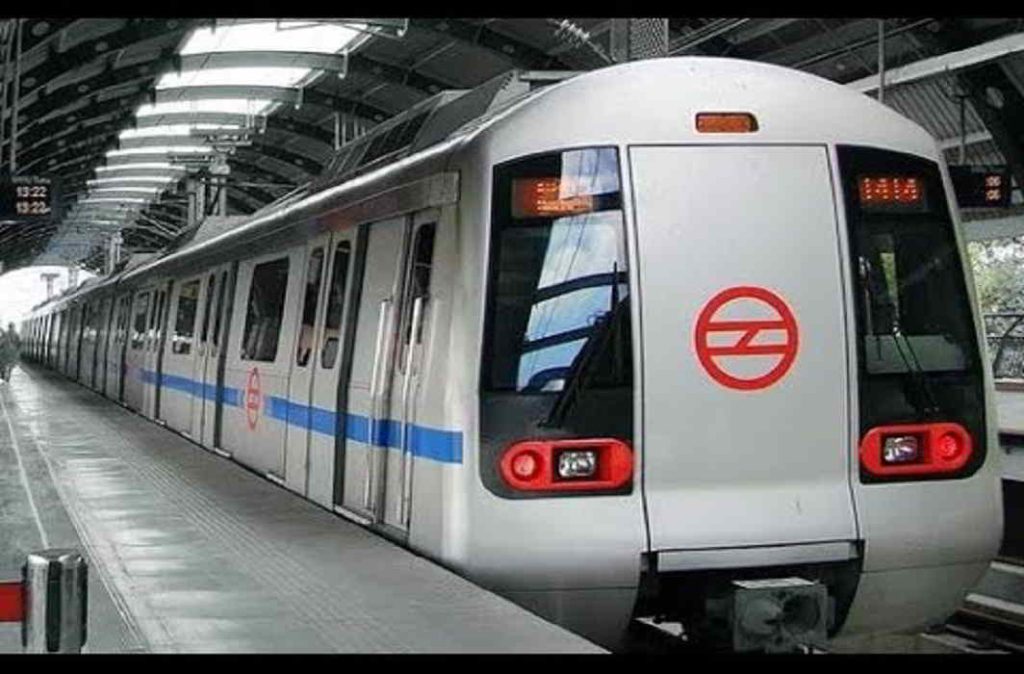The Delhi Metro Blue Line, a behemoth among the rapid transit lines of the Delhi Metro Rail Corporation (DMRC), serves as the backbone of Delhi’s public transportation system. This high-content article delves into the Blue Line, exploring its stations, interchanges, routes, and extensions, making it your one-stop guide for navigating Delhi’s blue artery.
Stations and Interchanges: Charting Your Course
The Blue Line boasts a network of 58 stations, categorized into two sections: The Main Line (Line 3) and the Branch Line (Line 4).
Main Line (Line 3): Dwarka Sector 21 – Noida Electronic City (50 Stations)
- Dwarka Sector 21: The westernmost terminus, offering connectivity to Dwarka sub-city.
- Dwarka Sector 18 – Barakhamba Road: This stretch serves prominent areas like Dwarka, Delhi Cantonment, and Connaught Place.
- Indraprastha: A crucial interchange station connecting the Blue Line with the Red Line (Dilshad Garden – Rithala).
- Yamuna Bank: Another vital interchange, connecting the Blue Line with the Pink Line (Majlis Park – Shiv Vihar).
Branch Line (Line 4): Yamuna Bank – Vaishali (8 Stations)
- Anand Vihar: An interchange station providing access to the Orange Line (Botanical Garden – New Ashok Nagar).
- Vaishali: The easternmost terminus, offering connectivity to the industrial hub of Ghaziabad.

source: metrorail news
Tourist places Along the Delhi Metro Blue Line
Western Corridor:
- National Crafts Museum & Hastkala Academy (Pragati Maidan): Station – Pragati Maidan. Immerse yourself in India’s rich heritage of textiles, pottery, metalwork, and more.
Central Corridor:
- Old Fort (Indraprastha): Station – Indraprastha. Explore a magnificent 16th-century fort boasting Mughal architecture and historical significance.
- Akshardham Temple (Akshardham): Station – Akshardham. Witness a modern architectural marvel showcasing Hindu culture and spirituality.
- India Gate (Central Secretariat): Station – Central Secretariat. Pay homage to India’s fallen soldiers at this iconic war memorial.
- Raj Ghat (ITO): Station – ITO (Note: Entry and exit at ITO are currently closed as of May 21, 2024. Check DMRC website for updates). Visit the memorial dedicated to Mahatma Gandhi, the father of Indian independence.
- Jama Masjid (Chandni Chowk): Station – Chandni Chowk. Delve into the heart of Old Delhi and explore this historic mosque, one of the largest in India.
Eastern Corridor:
- Agrasen ki Baoli (RK Puram): Station – RK Puram. Descend into a fascinating stepwell, an architectural marvel used for water storage and social interaction.
- Purana Qila (ITO): Station – ITO (Note: Entry and exit at ITO are currently closed as of May 21, 2024. Check DMRC website for updates). Explore another historic fort showcasing the architectural styles of various dynasties.
Bonus Tip:
- Connaught Place (CP): Station – Rajiv Chowk. This bustling commercial center offers a vibrant mix of shops, restaurants, and cafes. Take a break from sightseeing and soak in the local atmosphere.
Metro Route and Extensions: A Growing Network
The Blue Line’s route stretches across 65 kilometers, connecting prominent areas of Delhi, Noida, and Ghaziabad. Here’s a breakdown of its path:
- Western Corridor: Dwarka Sector 21 – Barakhamba Road, catering to Delhi’s western neighborhoods.
- Central Corridor: Barakhamba Road – Indraprastha, traversing the heart of the city.
- Eastern Corridor: Indraprastha – Noida Electronic City and Vaishali, extending connectivity to Delhi’s eastern frontiers.
The Blue Line has undergone several extensions since its inauguration in 2005, constantly expanding its reach:
- 2006: Dwarka Sector 9 and Dwarka Sector 21 stations were added.
- 2009: The line was extended to Noida City Centre and Yamuna Bank.
- 2010: Dwarka Sector 9 and Dwarka Sector 21 stations were connected.
- 2011: The Vaishali extension, including the Anand Vihar interchange, was opened.
Future Extensions: Plans are underway to further extend the Blue Line towards Noida Sector 62, aiming to enhance connectivity in Noida’s expanding sectors.
Beyond Stations: Unveiling the Blue Line’s Significance
The Blue Line plays a pivotal role in Delhi’s transportation network, offering several advantages:
- Reduced Traffic Congestion: By providing a fast and reliable alternative to private vehicles, the Blue Line has significantly reduced traffic congestion on Delhi’s roads.
- Improved Connectivity: The extensive network connects various business districts, residential areas, and tourist attractions, making commutes easier and faster.
- Environmental Benefits: By encouraging the use of public transportation, the Blue Line contributes to cleaner air and a more sustainable city.
- Economic Growth: Improved connectivity fosters economic activity by facilitating the movement of people and goods within the National Capital Region (NCR).
Stations and Interchanges: Charting Your Course
The Blue Line boasts a network of 58 stations, categorized into two sections: The Main Line (Line 3) and the Branch Line (Line 4).
Main Line (Line 3): Dwarka Sector 21 – Noida Electronic City (50 Stations)
- Dwarka Sector 21: The westernmost terminus, offering connectivity to Dwarka sub-city.
- Dwarka Sector 18 – Barakhamba Road: This stretch serves prominent areas like Dwarka, Delhi Cantonment, and Connaught Place.
- Indraprastha: A crucial interchange station connecting the Blue Line with the Red Line (Dilshad Garden – Rithala).
- Yamuna Bank: Another vital interchange, connecting the Blue Line with the Pink Line (Majlis Park – Shiv Vihar).
Branch Line (Line 4): Yamuna Bank – Vaishali (8 Stations)
- Anand Vihar: An interchange station providing access to the Orange Line (Botanical Garden – New Ashok Nagar).
- Vaishali: The easternmost terminus, offering connectivity to the industrial hub of Ghaziabad.
Delhi Metro Blue Line Route Map:

source: Fabhotels.com
More info on Blue Line metro
Blue line metro timings:
| Station Name | Interchange Lines | Timings (First & Last Train) |
|---|---|---|
| Dwarka Sector 21 | – | Approx. 5:30 AM – 11:00 PM |
| Dwarka Sector 18 | – | Approx. 5:30 AM – 11:00 PM |
| Dwarka Sector 13 | – | Approx. 5:30 AM – 11:00 PM |
| Dwarka Sector 10 | – | Approx. 5:30 AM – 11:00 PM |
| Najafgarh | – | Approx. 5:30 AM – 11:00 PM |
| Delhi Cantonment | – | Approx. 5:30 AM – 11:00 PM |
| R.K. Puram | – | Approx. 5:30 AM – 11:00 PM |
| Moti Nagar | – | Approx. 5:30 AM – 11:00 PM |
| Ramesh Nagar | – | Approx. 5:30 AM – 11:00 PM |
| Rajouri Garden | Pink Line | Approx. 5:30 AM – 11:00 PM |
| Patel Nagar | – | Approx. 5:30 AM – 11:00 PM |
| Shivaji Place | – | Approx. 5:30 AM – 11:00 PM |
| Nangloi | – | Approx. 5:30 AM – 11:00 PM |
| Brigade Road | – | Approx. 5:30 AM – 11:00 PM |
| Kirti Nagar | – | Approx. 5:30 AM – 11:00 PM |
| Moolchand | – | Approx. 5:30 AM – 11:00 PM |
| Lajpat Nagar | – | Approx. 5:30 AM – 11:00 PM |
| Sarita Vihar | – | Approx. 5:30 AM – 11:00 PM |
| Nehru Place | – | Approx. 5:30 AM – 11:00 PM |
| Kalkaji Mandir | Magenta Line | Approx. 5:30 AM – 11:00 PM |
| Okhla NS | – | Approx. 5:30 AM – 11:00 PM |
| Sukhdev Vihar | – | Approx. 5:30 AM – 11:00 PM |
| Hauz Khas | Magenta Line | Approx. 5:30 AM – 11:00 PM |
| Green Park | – | Approx. 5:30 AM – 11:00 PM |
| Malviya Nagar | – | Approx. 5:30 AM – 11:00 PM |
| Lajpat Nagar Extension | – | Approx. 5:30 AM – 11:00 PM |
| Saidulajab | – | Approx. 5:30 AM – 11:00 PM |
| INA Colony | Yellow Line | Approx. 5:30 AM – 11:00 PM |
| 德里हाट (Dilli Haat) | – | Approx. 5:30 AM – 11:00 PM |
| INA | – | Approx. 5:30 AM – 11:00 PMpen_spark |
Fare prices:
| Distance (in KM) | Fare (Monday-Saturday) | Fare (Sunday & National Holidays) |
|---|---|---|
| Upto 5 | ₹ 6 | ₹ 4 |
| 5 – 12 | ₹ 10 | ₹ 8 |
| 12 – 21 | ₹ 20 | ₹ 15 |
| 21 – 32 | ₹ 30 | ₹ 25 |
| Above 32 | ₹ 50 | ₹ 40 |
Latest News and Updates (May 21, 2024):
- Service Update: As of May 19, 2024, entry and exit at ITO Metro Station remain closed until further notice. Be sure to check the DMRC website (https://delhimetrorail.com/) for real-time updates before your commute.
- Noida Extension Update: The Noida Sector 51 to Greater Noida Aqua Line, managed by NMRC, remains a separate entity and does not currently offer direct interchange with the Blue Line.
In Conclusion:
The Delhi Metro Blue Line is a testament to India’s growing infrastructure and commitment to sustainable urban development. As the network continues to expand, the Blue Line will undoubtedly remain the lifeline of Delhi’s transportation system, ensuring swift and convenient commutes for millions of residents. So, the next time you’re navigating the capital, hop on the Blue Line and experience Delhi like a true local!
Frequently Asked Questions:
A: The Blue Line boasts 58 stations, with two sections: the Main Line (50 stations) and the Branch Line (8 stations).
A: Trains operate roughly from 5:30 AM to 11:00 PM. However, it’s always best to check the DMRC website (https://www.delhimetrorail.com/) for real-time updates.
A: Fares depend on the distance traveled. Up to 5 kilometers costs ₹6 (weekdays) or ₹4 (weekends/holidays), with prices increasing for longer distances. Check the full fare table in the article for details.
A: The Blue Line connects you to various tourist gems! Explore Old Fort, India Gate, Akshardham Temple, and many more!
A: Yes! As of May 21, 2024, entry and exit at ITO Station are closed. Always check the DMRC website for service updates before your commute
Suggested articles:
Delhi Metro Green line: Latest News, Timings and Stations
Shaheed Sthal Metro Station Delhi/NCR: Routes, Location & Timings








































